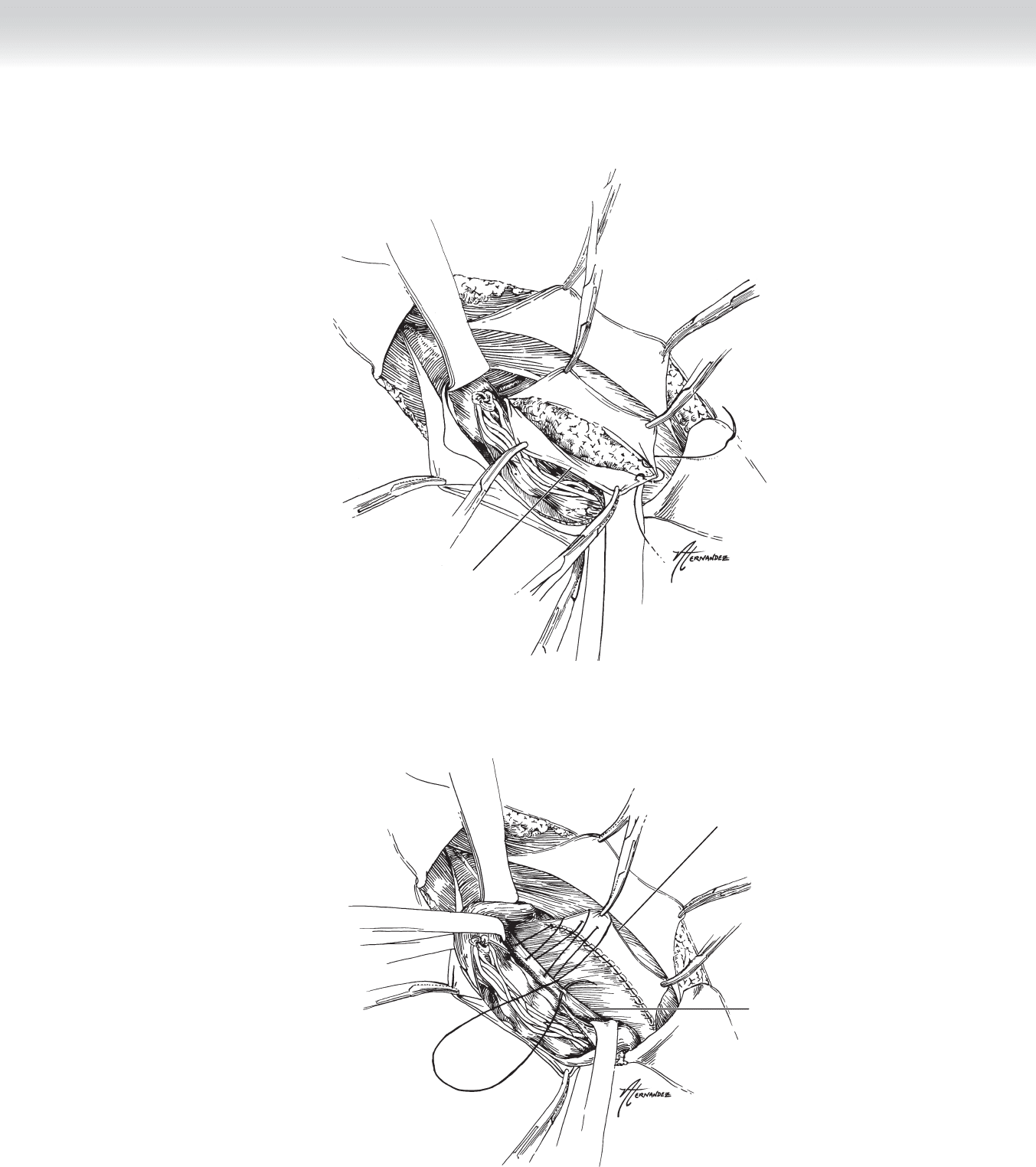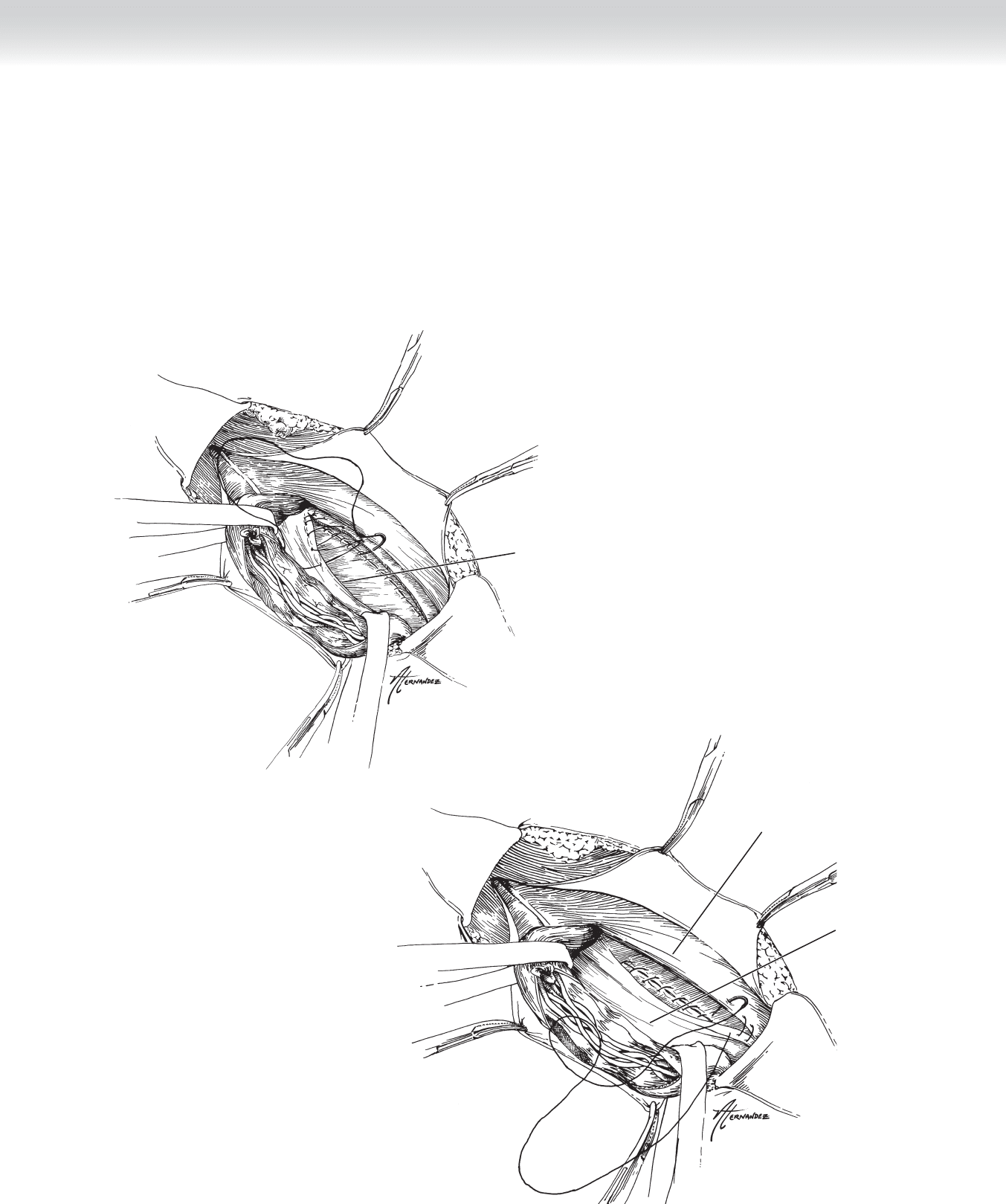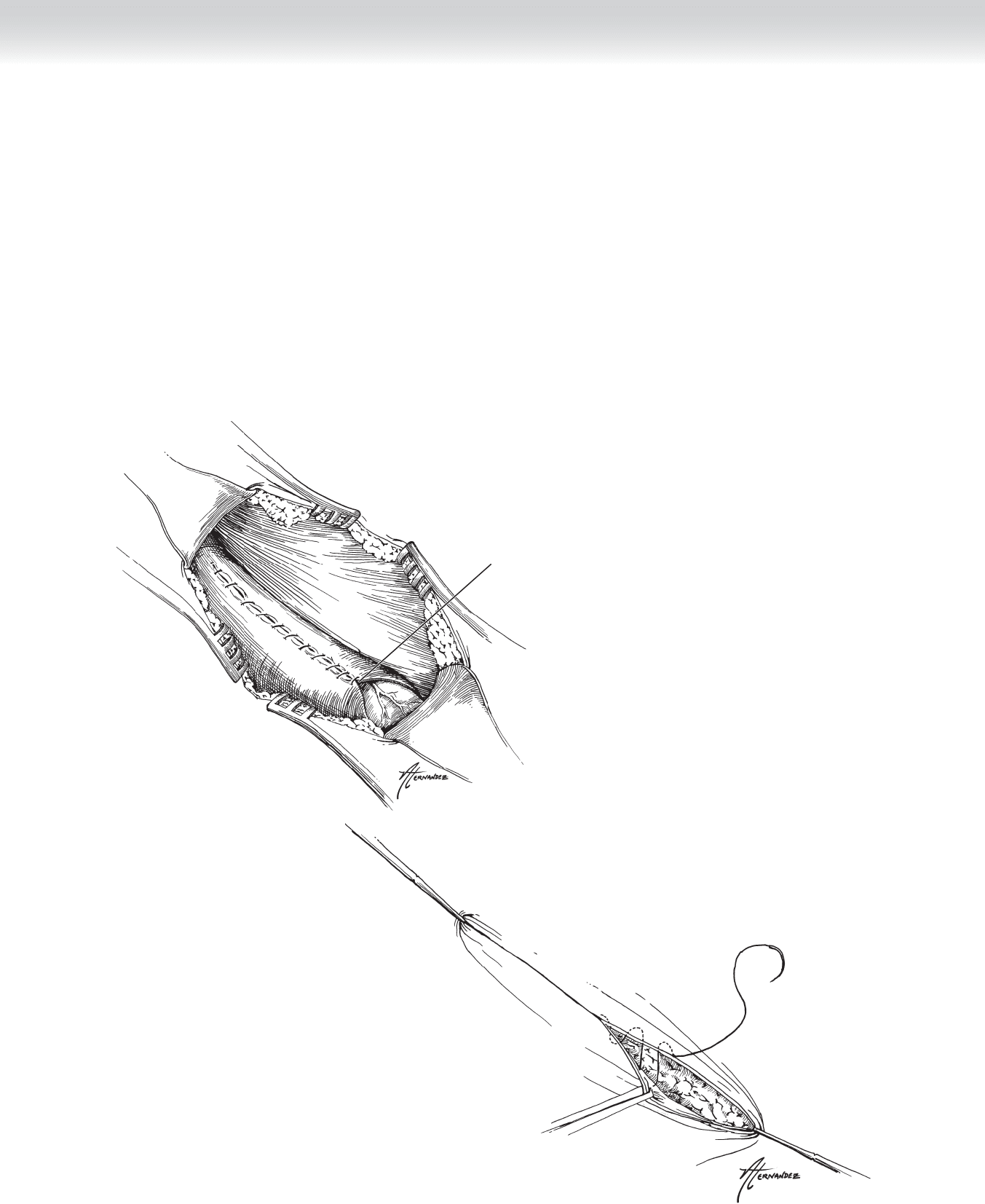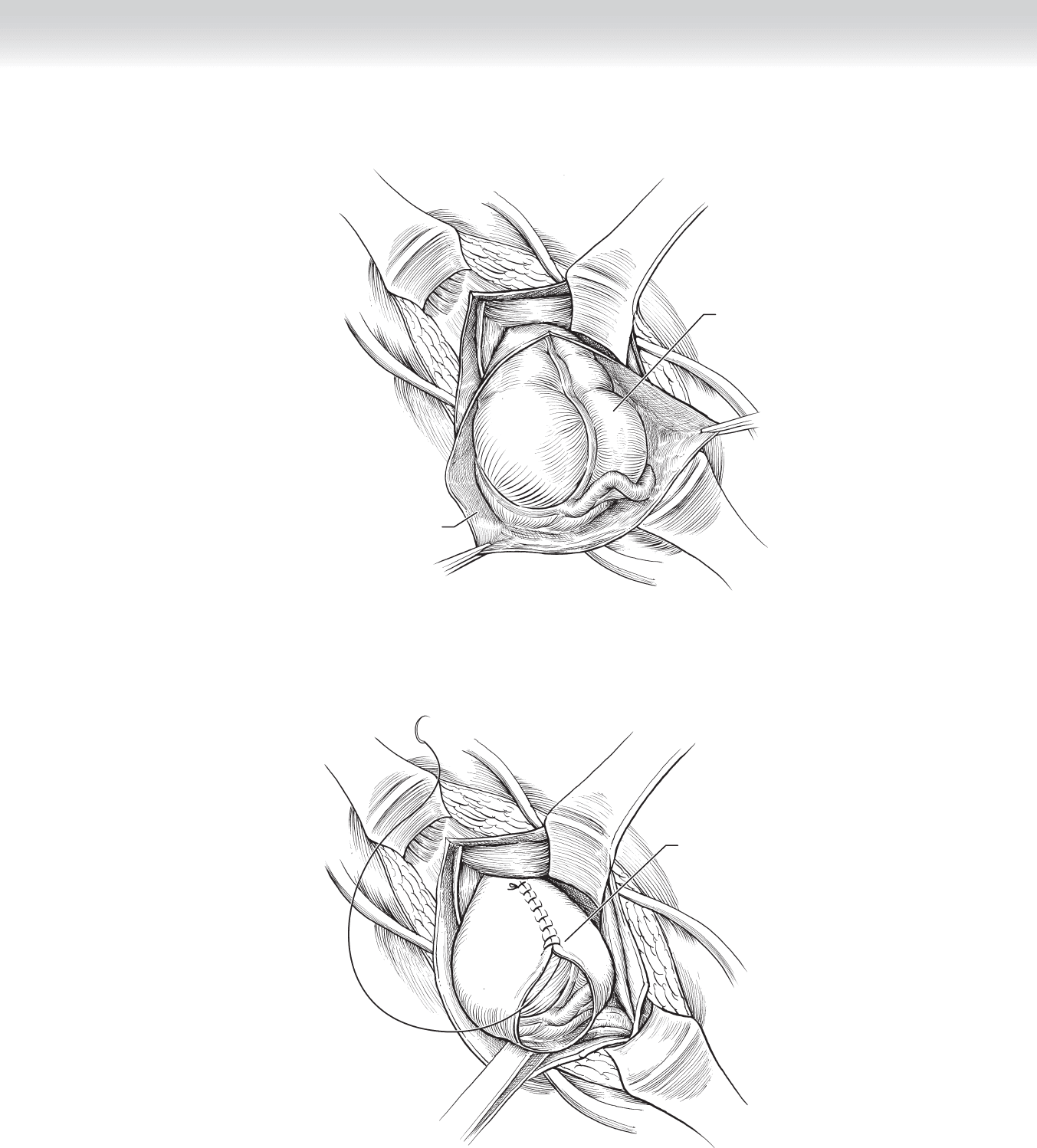Townsend Courtney M.Jr., Evers B. Mark. Atlas of General Surgical Techniques: Expert Consult
Подождите немного. Документ загружается.


CHAPTER 75 • Inguinal Herniorrhaphy—Shouldice 829
Inferior cut edge of
transversalis fascia
FIGURE 75 –10
Superior cut edge
of transversalis fascia
Shelving edge of
inguinal ligament
FIGURE 75 –11

830 Section XI • Hernias
◆ The second polypropylene suture is started laterally at the internal ring, and this third layer
is used to oversew the second layer reinforcing the transversalis/internal oblique to inguinal
ligament approximation (Figure 75-12).
◆ After reaching the pubic tubercle again, in the fi nal layer, the internal oblique muscle is
sewn to the inguinal ligament. The suture is then tied at the inguinal ring (Figure 75-13).
Shelving edge of
inguinal ligament
FIGURE 75 –12
Internal oblique
aponeurosis
Inguinal
ligament
FIGURE 75 –13

CHAPTER 75 • Inguinal Herniorrhaphy—Shouldice 831
3. CLOSING
◆ The spermatic cord is returned to its anatomic position, and the external oblique is closed
with running 3-0 absorbable suture, such as Vicryl (Figure 75-14).
◆ Scarpa’s fascia is reapproximated with 3-0 Vicryl.
◆ Standard skin closure is the surgeon’s choice of running subcuticular absorbable suture, such
as 4-0 Monocryl or interrupted permanent suture, such as staples or 2-0 polypropylene
(Figure 75-15).
Recreated external
inguinal ring
FIGURE 75 –14
FIGURE 75 –15

832 Section XI • Hernias
STEP 4: POSTOPERATIVE CARE
◆ Ice pack, oral hydrocodone or propoxyphene, and stool softeners are the standard post-
operative orders.
◆ Activity and driving should be restricted until the patient is comfortable and no longer in
need of pain medication.
◆ Severe pain and swelling of the testicle should be immediately evaluated for the possibility
of ischemia.
STEP 5: PEARLS AND PITFALLS
◆ Hemostasis during sac dissection should be meticulous to avoid injury to the pampiniform
plexus and the development of wound hematomas.
◆ Care must be taken to avoid crushing, burning, or entrapment of the cutaneous nerves in
the inguinal canal to decrease the possibility of postoperative chronic pain syndromes.
◆ Patients should be thoroughly educated about the postoperative disability after a tension-
producing repair of inguinal hernia.
SELECTED REFERENCES
1. Hay JM, Boudet MJ, Fingerhut A, et al: Shouldice inguinal hernia repair in the male adult: The gold
standard? A multicenter controlled trial in 1578 patients. Ann Surg 1995;222:719-727.
2. Shouldice EE: The treatment of hernia. Ont Med Rev 1953;20:670-684.
3. Welsh DR, Alexander MA: The Shouldice repair. Surg Clin North Am 1993;73:451-469.

833
STEP 1: SURGICAL ANATOMY
◆ A sliding inguinal hernia is defi ned as one in which a viscus or its attendant mesentery
constitute a part of the wall of the hernia sac.
◆ Although sliding hernias have been reported in all three types of groin hernia, they are
most common in the indirect location.
◆ Again, although a wide variety of organs have been reported, including female adnexa,
appendix, ileum, ureter, and bladder, the sliding component most commonly is the cecum
on the right side of the body and the sigmoid colon on the left.
◆ The part of the wall of the hernia sac involved is usually the posterior lateral region.
STEP 2: PREOPERATIVE CONSIDERATIONS
◆ Sliding hernias are rarely identifi ed preoperatively, and in fact there is little reason to worry
about doing so.
◆ Preoperative preparation should follow guidelines outlined in earlier chapters.
STEP 3: OPERATIVE STEPS
1. INCISION
◆ The standard incisions described in Chapter 71 are suffi cient.
Sliding Inguinal Hernia
Thomas D. Kimbrough
CHAPTER
76

834 Section XI • Hernias
2. DISSECTION
◆ The most important step in dealing with a sliding hernia is its recognition. Failure to do so
can result in unnecessary dissection leading to injury to the involved organ or its blood
supply.
◆ It is important to differentiate between adhesions from abdominal organs to the inner sur-
face of the hernia sac and true sliding hernias. Adhesions can be carefully lysed and the
freed organ reduced back into the abdominal cavity.
◆ A right-sided sliding hernia is illustrated in Figure 76-1. Note the cecum forming part of
the posterior lateral wall of the opened hernia sac.
3. CLOSURE
◆ Once any adhesions are taken down, the peritoneum is sewn shut, closing the hernia sac as
shown in Figure 76-2. Care should be taken to avoid catching any part of the colon and its
mesentery in the closure.
◆ Because a sliding hernia is a modifi cation of an indirect hernia, once the sac is closed, it and
the attached colon can be reduced back into the preperitoneal space in the fashion described
in Chapter 71.
◆ Similarly, repair can then proceed by one of the techniques appropriate for an indirect
hernia.

CHAPTER 76 • Sliding Inguinal Hernia 835
Cecum
MC
Hernia sac/
peritoneum opened
FIGURE 76 –1
Closing peritoneum
FIGURE 76 –2

836 Section XI • Hernias
STEP 4: POSTOPERATIVE CARE
◆ There are no special considerations or steps necessary in postoperative care different from
those mentioned in Chapter 71.
STEP 5: PEARLS AND PITFALLS
◆ Mentioned earlier but worth repeating, prompt recognition of the presence of a sliding her-
nia and avoidance of unnecessary and potentially damaging dissection is desirable.
◆ Because most of these are variants on the standard indirect hernia, any repair appropriate
for a large version of that hernia will suffi ce here.
SELECTED REFERENCE
1. Nyhus LM, Condon RE (eds): Hernia, 4th ed. Philadelphia, JB Lippincott, 1995.

837
INTRODUCTION
◆ The incidence of indirect inguinal hernias (which comprise 99% of the hernias found in
small children) ranges from 1% to 5% of the population, with a male-to-female ratio of 8:1
to 10:1. Premature infants are at greater risk for developing inguinal hernias, with reported
incidences ranging from 7% to 30% for boys and 2% for girls. The risk of incarceration is
inversely proportional to the age of the patient and may exceed 60% in the fi rst 6 months
of life. Most neonatologists and pediatric surgeons recommend repair of inguinal hernias in
premature babies before discharge from the hospital. The incidence of bilateral inguinal
hernias in children and routine contralateral groin exploration at the time of repair are con-
troversial topics. The possibility that bilateral inguinal hernias will be present at operation is
greater in younger patients, but the risk of bilaterality subsequently decreases to 41% for
children 2 to 16 years of age. Incidence of bilateral inguinal hernias seems to be greater in
female patients in all age groups, with reported values ranging from 20% to 50%. Patients
with ventriculoperitoneal (VP) shunts, peritoneal dialysis catheters, connective tissue disor-
ders such as Ehlers-Danlos syndrome, and cystic fi brosis have a high enough incidence of
bilaterality to justify routine contralateral exploration. Laparoscopic exploration of the con-
tralateral inguinal ring by inserting a small 70-degree scope (or 120-degree, if available)
through the hernia sac is a recent approach that is helpful in avoiding unnecessary and po-
tentially morbid contralateral groin explorations. I continue to perform routine contralateral
explorations in all premature infants with an inguinal hernia.
STEP 1: SURGICAL ANATOMY
◆ The processus vaginalis, which is a peritoneal diverticulum that extends in utero through the
internal inguinal ring, is dragged along with testicular descent into the scrotum, where the
portion surrounding the testicle will become the tunica vaginalis while the rest of the proces-
sus obliterates before the child’s birth. Persistence of a patent processus vaginalis may lead to
indirect inguinal hernias, hydroceles of the cord, or communicating hydroceles. Most ingui-
nal hernias in children (99%) are indirect; that is, the sac originates lateral to the inferior
epigastric vessels (although it may extend past them) and is close (on the anteromedial side)
to the spermatic vessels and the vas deferens. All cord structures are enveloped by the deep
spermatic fascia, which is very thin and translucent, and more superfi cially by the cremaster
muscle, which originates from the internal oblique muscle.
CHAPTER
77
Inguinal Hernias in Infants
and Small Children
Carlos A. Angel

838 Section XI • Hernias
STEP 2: PREOPERATIVE CONSIDERATIONS
◆ In most children, laboratory examinations or antibiotics are not indicated before hernia
repair. The time at which ingesting clear fl uids is stopped depends on the age of the patient
and ranges from 3 to 6 hours before the procedure. Most anesthesiologists will administer
an anxiolytic agent such as midazolam in the preoperative area to reduce separation anxiety
and the fear that arises from an unfamiliar environment. Anesthetic technique varies
depending on the level of comfort and experience of the anesthesiologist. In most patients,
general endotracheal anesthesia will be preferred. In selected cases, such as very small
infants with chronic pulmonary disease, in which endotracheal intubation can result in pro-
longed mechanical ventilatory support in the postoperative period, the procedure can be
safely performed with the infant under a regional anesthetic such as a caudal block. Preop-
erative planning should include 23-hour postoperative observation and monitoring in all
patients who were born prematurely within the previous 4 to 6 months.
STEP 3: OPERATIVE STEPS
1. INCISION
◆ The patient is placed on the operating table in the supine position. After anesthesia is
induced, the lower abdomen, both groins, penis, and scrotum are prepped with a topical
antiseptic solution and draped in a sterile fashion. A small (3- to 4- cm) incision is made
along the lower abdominal crease (Figure 77-1). The subcutaneous fat is grasped between
mosquito hemostats and divided with electrocautery at very low settings. Two crossing veins
can be either pushed off the midline, cauterized, or tied. Division of the subcutaneous fat
stops when Scarpa’s fascia becomes evident. Scarpa’s fascia has a pearly, shiny appearance.
Scarpa’s fascia is opened with scissors, and blunt dissection is used, starting on the lateral
aspect of the incision and working medially to expose the external oblique aponeurosis and
the external inguinal ring. The external oblique aponeurosis is opened sharply, and this
incision is extended until opening the external inguinal ring (Figure 77-2). Care must be
taken to avoid injury of the ilioinguinal nerve. The spermatic cord is grasped gently, avoid-
ing any manipulation of the vas deferens. At this stage of the operation, bringing the testicle
into the operative fi eld should be avoided.
